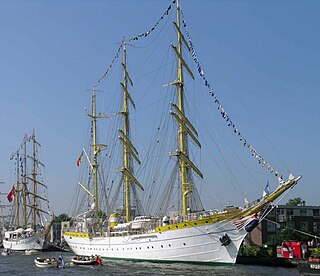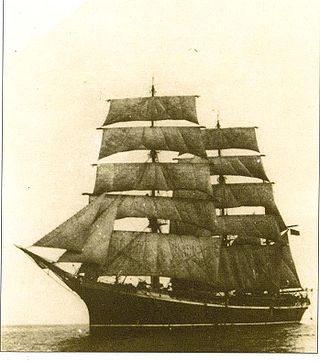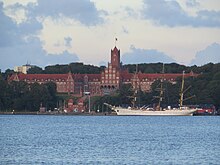
A tall ship is a large, traditionally-rigged sailing vessel. Popular modern tall ship rigs include topsail schooners, brigantines, brigs and barques. "Tall ship" can also be defined more specifically by an organization, such as for a race or festival.

Gorch Fock I is a German three-mast barque, the first of a series built as school ships for the German Reichsmarine in 1933.

USCGC Eagle (WIX-327), formerly the Horst Wessel and also known as the Barque Eagle, is a 295-foot (90 m) barque used as a training cutter for future officers of the United States Coast Guard. She is one of only two active commissioned sailing vessels in the United States military today, along with USS Constitution which is ported in Boston Harbor. She is the seventh Coast Guard cutter to bear the name in a line dating back to 1792, including the Revenue Cutter Eagle.

Statsraad Lehmkuhl is a three-masted barque rigged sail training vessel owned and operated by the Statsraad Lehmkuhl Foundation. It is based in Bergen, Norway and contracted out for various purposes, including serving as a school ship for the Royal Norwegian Navy.

Alexander von Humboldt is a German sailing ship originally built in 1906 by the German shipyard AG Weser at Bremen as the lightship Reserve Sonderburg. She was operated throughout the North and Baltic Seas until being retired in 1986. Subsequently, she was converted into a three masted barque by the German shipyard Motorwerke Bremerhaven and was re-launched in 1988 as Alexander von Humboldt. In 2011 the ship was taken off sail-training and sent to the Caribbean for the charter business, then she was converted to a botel.

Mircea is a three-masted barque, built in 1938 in Hamburg by the Blohm & Voss shipyard as a training vessel for the Romanian Navy. Her design is based on the successful plans of Gorch Fock; the last of a series of four sister ships. The ship is named after the Wallachian Voivode, Mircea the Elder. After World War II she was temporarily taken over by the USSR, but later returned to Romania. In 1966, she was overhauled by Blohm & Voss.

ARM Cuauhtémoc is a sail training vessel of the Mexican Navy, named for the last Mexica Hueyi Tlatoani Cuauhtémoc who was captured and executed in 1525.

NRP Sagres is a tall ship and school ship of the Portuguese Navy since 1961. As the third ship with this name in the Portuguese Navy, she is sometimes referred to as Sagres III.

SegelschulschiffNiobe was a tall ship used by the Reichsmarine to train cadets and aspiring NCOs. She sank during a white squall on 26 July 1932, with the loss of 69 lives. A memorial monument to Niobe was erected at Gammendorfer Strand on Fehmarn island, within view of the site of the sinking.

Glenlee is a steel-hulled three-masted barque, built as a cargo ship at Port Glasgow under that name in 1896 for Glasgow owners. With later owners she was named Islamount and Clarastella. From 1922 she was the sail training ship Galatea in the Spanish Navy. Since 1993, carrying her original name, Glenlee has been a museum ship at the Riverside Museum on Pointhouse Quay, Glasgow, known as The Tall Ship at Glasgow Harbour.

HNoMS Sleipner was a 1. class gunboat built for the Royal Norwegian Navy. Like all other Norwegian gunships of her era, she carried a heavy armament on a diminutive hull. The vessel was built at the Naval Yard at Horten, and had yard number 56.

SMS König Wilhelm was an armored frigate of the Prussian and later the German Imperial Navy. The ship was laid down in 1865 at the Thames Ironworks shipyard in London, originally under the name Fatih for the Ottoman Empire. She was purchased by Prussia in February 1867, launched in April 1868, and commissioned into the Prussian Navy in February 1869. The ship was the fifth ironclad ordered by the Prussian Navy, after Arminius, Prinz Adalbert, Friedrich Carl, and Kronprinz. She was built as an armored frigate, armed with a main battery of sixteen 24 cm (9.4 in) and five 21 cm (8.3 in) guns; several smaller guns and torpedo tubes were added later in her career.

The Naval Academy Mürwik is the main training establishment for all German Navy officers and in 1910 replaced the German Imperial Naval Academy in Kiel.

ARA Libertad (Q-2) is a steel-hulled, full-rigged, class "A" sailing ship that serves as a school vessel in the Argentine Navy. One of the largest and fastest tall ships in the world, holder of several speed records, she was designed and built in the 1950s by the Río Santiago Shipyard, Ensenada, Argentina. Her maiden voyage was in 1961, and she continues to be a training ship with yearly instruction trips for the graduating naval cadets as well as a traveling goodwill ambassador, having covered more than 800,000 nautical miles (1,500,000 km) across all seas, visited about 500 ports in more than 60 countries, and trained more than 11,000 navy graduates.

The Nautilus class was a pair of minelaying cruisers built by the Imperial German Navy. Nautilus was laid down in 1905 and completed by 1907, and SMS Albatross was laid down in 1907, and completed in 1908. Both ships were built by the AG Weser shipyard in Bremen, but to slightly different designs. Nautilus had a clipper bow, while Albatross had a bow similar to contemporary German light cruisers. The ships were armed with a battery of 8.8 cm (3.5 in) guns and had a capacity of 168–288 naval mines.

København was a Danish, British-built five-masted barque used as a naval training vessel until its disappearance after December 22, 1928. Built for the Danish East Asiatic Company in 1921, it was the world's largest sailing ship at the time, and primarily served for sail training of young cadets.

Guayas is a sail training ship of the Ecuadorian Navy. Launched in 1976, it was named in jointly in honor of Chief Guayas, the Guayas river, and Guayas, the first steamship that was constructed in South America in 1841, and is displayed on the Ecuadorian coat of arms. The ship's home base is Guayaquil, Ecuador.

ARC Gloria is a three-masted barque. She is a training ship and official flagship of the Colombian Navy.

SMS Charlotte was a German screw corvette built for the Kaiserliche Marine in the 1880s, being laid down in April 1883, launched in September 1885, and commissioned in November 1886. The only vessel of her class, Charlotte was the last sailing warship built for the German navy. She was armed with a battery of eighteen 15 cm (5.9 in) guns.

SMS Augusta was a wooden steam corvette built in the 1860s, the lead ship of the Augusta class. She had one sister ship, Victoria; the ships were armed with a battery of fourteen guns. Augusta was laid down in 1863 at the Arman Brothers shipyard in Bordeaux, France, and was launched in early 1864. Originally ordered by the Confederate States Navy, her delivery was blocked by the French Emperor Napoleon III, and she was instead sold to the Prussian Navy in May 1864. The Prussians had been in search of vessels to strengthen their fleet before and during the Second Schleswig War against Denmark, but Augusta arrived too late to see action in the conflict.



























